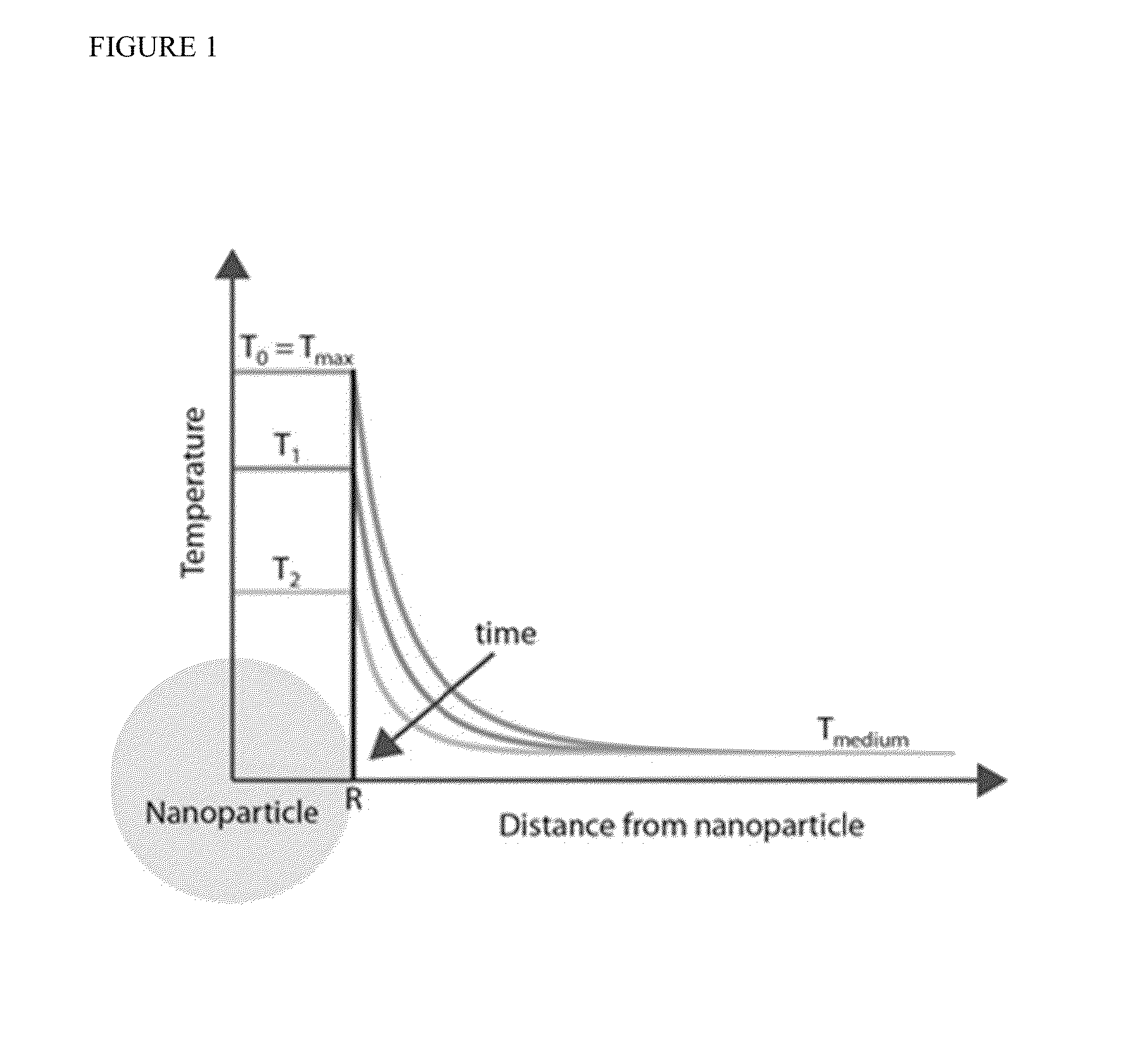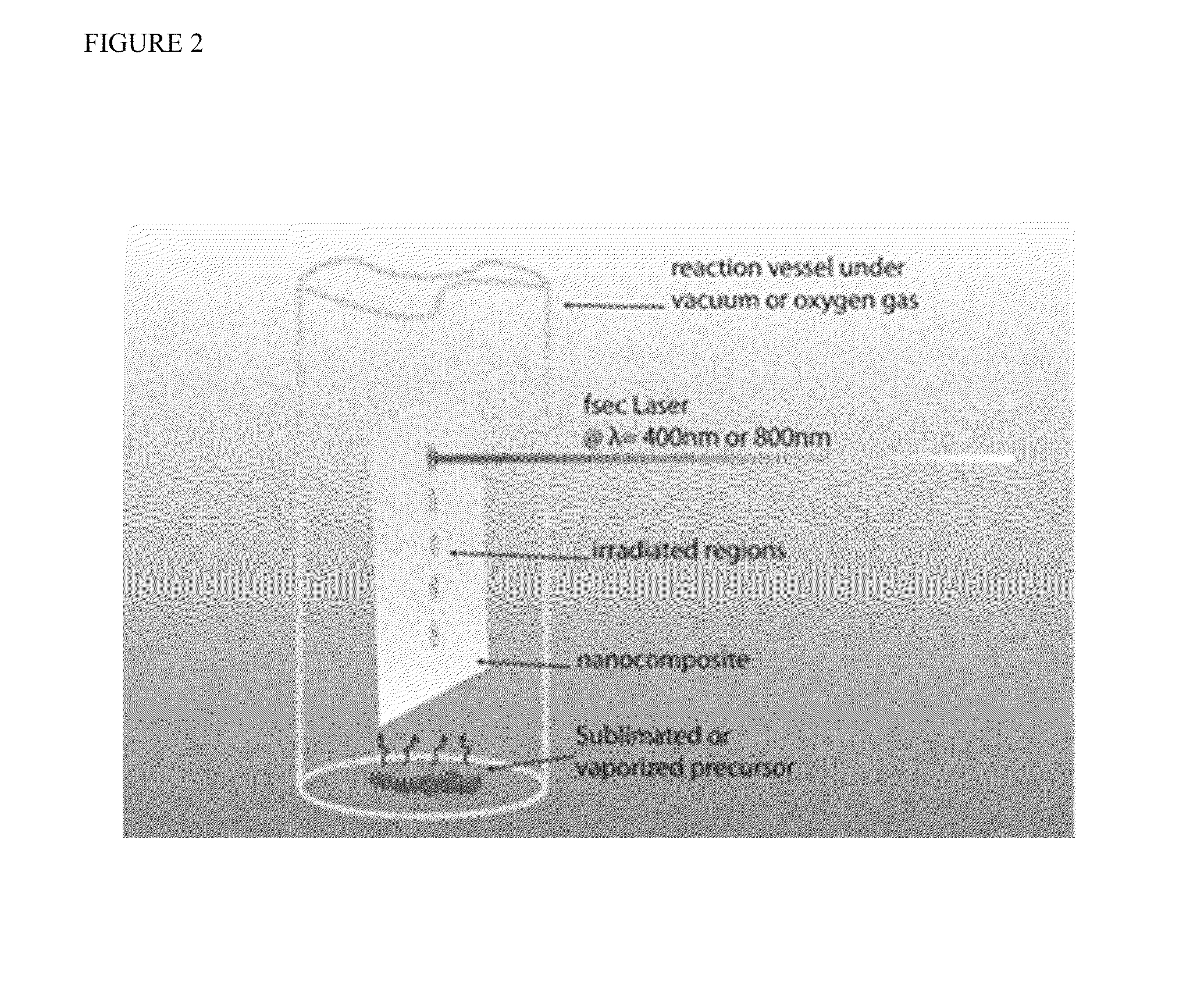Scalable processing of nanocomposites using photon-based methods
a nanocomposites and photon-based technology, applied in the direction of liquid/solution decomposition chemical coating, nuclear engineering, transportation and packaging, etc., can solve the problems of limiting the scale, random distribution of nanoparticles, and not allowing the nanoscale patterning of preexisting nanofeatures within a matrix, or the creation of more complicated nanostructures such as core-shell nanoparticles
- Summary
- Abstract
- Description
- Claims
- Application Information
AI Technical Summary
Benefits of technology
Problems solved by technology
Method used
Image
Examples
example 1
[0033]The starting material for the first series of experiments was a silver polymer nanocomposite synthesized using a modified CVD nanoinfusion process. This process begins by placing a FEP polymer film in a reaction vessel with vinyltriethylsilane-(hexafluoroacetylacetonate)silver(I) [Ag(CF3COCHCOCF3)(C8H18—Si)], an organometallic silver precursor. This was performed in a glove box under an argon atmosphere in order to keep the silver precursor from reacting with oxygen in air. The bottom portion of the reaction vessel, which contained the silver precursor, was then placed in a dewar containing liquid nitrogen. After the precursor was frozen, the vessel was evacuated to a vacuum level of 100 mTorr. The vessel was then sealed, removed from the liquid nitrogen dewar, and allowed to return to room temperature (20° C.). This process was performed two more times to sufficiently remove any air trapped within the liquid precursor. Finally, the evacuated reaction vessel was placed in an o...
example 2
[0035]A similar procedure was also used to obtain a tungsten oxide nanocomposite. Using tungsten carbonyl [W(CO)6] as the organometallic precursor, the vessel was heated to 140° C. and held at that temperature for 3 hours to allow the tungsten carbonyl to sublimate and diffuse into the FEP polymer film. It was then heated to 165° C., the experimentally determined temperature at which tungsten carbonyl decomposed and held at that temperature for 2 hours, resulting in the nucleation of tungsten oxide nanoparticles within the bulk of the polymer film. This infusion process was performed twice to obtain a 2× WO3-FEP nanocomposite. The 2× WO3 nanocomposite was then placed in a reaction vessel with a small amount of the silver precursor described above. The vessel was evacuated and placed in an oven with an optical window and heated to 100° C. After 45 minutes at 100° C., the sample was selectively irradiated with femtosecond laser pulses. For this processing, the laser pulses were unampl...
example 3
[0037]Two different materials systems (a 2× Ag-FEP nanocomposite and a 2× WO3 nanocomposite) were patterned using different temperatures and laser irradiation conditions. They were both characterized using UV / Vis optical spectroscopy in order to determine the changes to their optical properties as a result of processing and were also characterized using TEM microscopy in order to observe structural and size changes in the nanoparticles in the polymer films.
[0038]Optical Characterization. The UV / Vis spectrum for an unprocessed 2× Ag nanocomposite is shown in FIG. 3 and shows a large SPR located at an optical wavelength of 402 nm. After exposing the nanocomposite for 20 minutes to 90 μJcm−2 pulses at 400 nm, the nanocomposite displayed a 40 nm red shift in its SPR to 442 nm (also shown in FIG. 3). It should be noted that the 2× Ag nanoparticles absorb very strongly at 400 nm while the other materials in the nanocomposite system absorb very weakly, and therefore the silver nanoparticle...
PUM
| Property | Measurement | Unit |
|---|---|---|
| Time | aaaaa | aaaaa |
| Pressure | aaaaa | aaaaa |
| Frequency | aaaaa | aaaaa |
Abstract
Description
Claims
Application Information
 Login to View More
Login to View More - R&D
- Intellectual Property
- Life Sciences
- Materials
- Tech Scout
- Unparalleled Data Quality
- Higher Quality Content
- 60% Fewer Hallucinations
Browse by: Latest US Patents, China's latest patents, Technical Efficacy Thesaurus, Application Domain, Technology Topic, Popular Technical Reports.
© 2025 PatSnap. All rights reserved.Legal|Privacy policy|Modern Slavery Act Transparency Statement|Sitemap|About US| Contact US: help@patsnap.com



